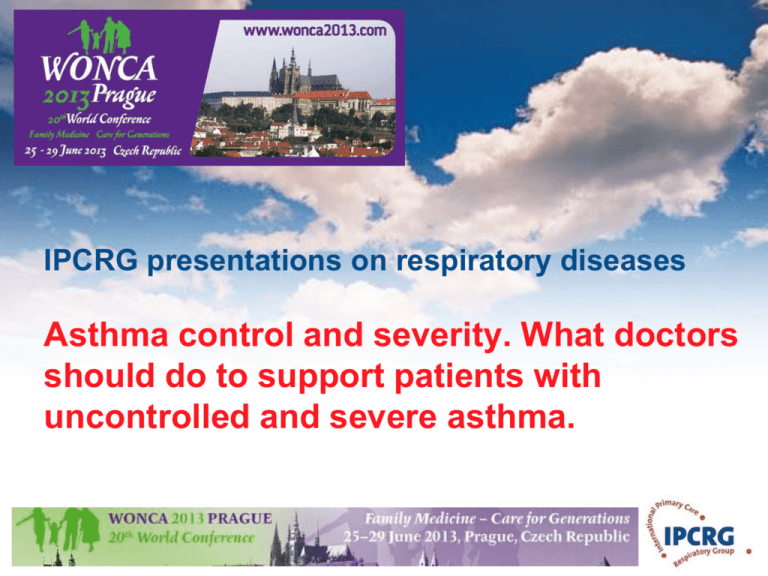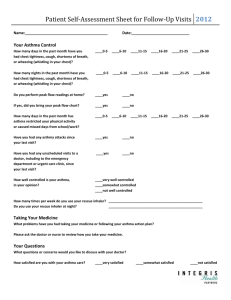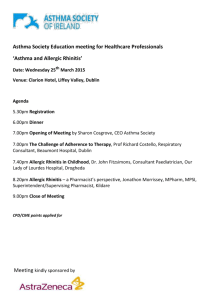What is asthma control? - the International Primary Care Respiratory
advertisement

IPCRG presentations on respiratory diseases Asthma control and severity. What doctors should do to support patients with uncontrolled and severe asthma. © IPCRG 2007 Jaime Correia de Sousa Miguel Román-Rodríguez © IPCRG 2007 Session Outline • • • Introduction • • • Group Work / Case vignettes Definition What is asthma control and reasons for poor control How to measure asthma control? Difficult to manage asthma: a practical guide Page 3 - © IPCRG 2013 Introduction Definition • Difficult to manage asthma is asthma that either the patient or the clinician finds difficult to manage. • A patient with difficult to manage asthma has daily symptoms and regular exacerbations despite apparently best treatment. Page 4 - © IPCRG 2013 Introduction • There are two main groups of patients with difficult to manage asthma: o People whose asthma has been controlled in the past but who have now lost control. o People whose asthma has never been controlled. Page 5 - © IPCRG 2013 Difficult to manage asthma Page 6 - © IPCRG 2013 Poorly controlled asthma: What should we do? © IPCRG 2007 1. What is asthma control 2. Reasons for poor asthma control • In groups of 3, please: 1. define asthma control 2. list 3 reasons for poor asthma control • After 3 m one member from each team should report to the group Page 8 - © IPCRG 2013 What is asthma control? As defined by the Global Initiative for Asthma (GINA), 2007 • • • • Minimal to no daytime asthma symptoms • • Normal lung function (FEV1 or PEF) No limitations on activities No nocturnal symptoms or awakenings Minimal to no need for reliever or rescue therapy No exacerbations Page 9 - © IPCRG 2013 www.ginasthma.org Reasons for poor asthma control • • • • • • • Wrong diagnosis or confounding illness Incorrect choice of inhaler or poor technique Concurrent smoking Concomitant rhinitis Unintentional or intentional nonadherence Individual variation in treatment response Under treatment Page 10 - © IPCRG 2013 Haughney J et al. Respir Med. 2008;102:1681–93. Clinical cases © IPCRG 2007 Group Work • • We will present a case vignette • After 5 m we will discuss the case in the plenary Please take your notes and discuss the case in small groups (3-5 persons) Page 12 - © IPCRG 2007 Case 1: Sara- 43 year old, goes for a routine asthma consultation: •• •• Never smoked Daytime symptoms > twice a week •• • Asthma since 1992medication In recentdiagnosis weeks used rescue • She is regularly taking inhaled beta-2 Atopic dermatitis since childhood Nocturnal awakenings Never tested for allergenic sensitivity 2/3 times a week agonists and corticosteroids medium dose fixed combination and salbutamol as needed Page 13 - © IPCRG 2013 Is her asthma controlled? Characteristic Controlled Partly controlled (All of the following) (Any present in any week) Daytime symptoms Twice or less per week More than twice per week Limitations of activities None Any Nocturnal symptoms / awakening None Any Need for rescue / “reliever” treatment Twice or less per week More than twice per week Normal < 80% predicted or personal best (if known) on any day Lung function (PEF or FEV1) Page 14 - © IPCRG 2013 Uncontrolled 3 or more features of partly controlled asthma present in any week www.ginasthma.org How do we measure asthma control? © IPCRG 2007 How do we measure asthma control ? • • • • History Prescription review Questionnaires Objective measures Page 16 - © IPCRG 2013 How to assess asthma control in practice? Simple tools that both healthcare providers and patients can use. - Asthma Control Questionnaire (ACQ) • 7-item questionnaire. Based upon day/night-time symptoms, daily activities, rescue bronchodilator - Royal College of Physicians (RCP) • 3 questions based upon day/night-time symptoms and daily activities - Asthma Control Test (ACT) • Validated instrument. 5 questions based upon day/night-time symptoms, rescue bronchodilator use and daily activities. - Control of Allergic Rhinitis and Asthma Test (CARAT) • Page 17 - © IPCRG 2013 Validated instrument. 4 questions on rhinitis + 6 on asthma. Available in several languages Juniper et al ERJ 1999;14:902-7, Br Med J 1990;301:651-653, Nathan J Allergy Clin Immun, 2004:113:59-65 Page 18 - © IPCRG 2013 Page 19 - © IPCRG 2013 Page 20 - © IPCRG 2013 Very poor If this criterion is important, not good enough Criteria / Tool Good enough Fully validated in all ages Recommended Clinically meaningful Highly Recommended Practical use in primary care consultations Flexible administration eg postal, telephone, self-completion, electronic Suitable for different age ranges: children and adults RCP 3 RCP 21 Questions Rules of two TM The 30 second Asthma Test TM ACQ ACT ATAQ Page 21 - © IPCRG 2013 Note 1: Availability in other languages does not necessarily mean that it is validated for use in that language. Check if the translation has been validated using appropriate methodology. Also, there may be cultural adaptations that are needed. Available in different languages (1) Objective measures Page 22 - © IPCRG 2013 Reasons for poor asthma control: Case 2 © IPCRG 2007 Case 2: Sara- 43 year old, goes for a routine asthma consultation: • • • • Never smoked Once we check asthma control and Atopic dermatitis since childhood we discover that she has an Asthma diagnosis since 1992 asthma • uncontrolled Never tested for allergenic sensitivity • What is next? Page 24 - © IPCRG 2007 Page 25 - © IPCRG 2013 How to review a patient with difficult to manage asthma SIMPLES • Smoking • Inhaler technique • Monitoring • Pharmacotherapy • Lifestyle • Education • Support Page 26 - © IPCRG 2013 Page 27 - © IPCRG 2013 Step1: confirm the diagnosis of asthma • If the patient is not responding as expected to asthma therapy: Confirm the asthma diagnosis and rule out (or in) confounding illness before changing or increasing medications • Tools for asthma diagnosis must be stratified by age • Objective measures of reversible airflow obstruction (spirometry, PEF) are important if available Page 28 - © IPCRG 2013 Diagnosing asthma in primary care IPCRG guidelines. Prim Care Respir J. 2006;15:20–34. • Compatible clinical history • Episodic or persistent dyspnoea, wheeze, tightness, cough Triggers (allergic, irritant) Risk factors for asthma development Consider occupational asthma for adults with recent onset Objective evidence Spirometry or peak expiratory flow Bronchoprovocation test (methacholine challenge) • Ancillary tests Chest x-ray Eosinophils, IgE level Allergy testing Exhaled nitric oxide Induced sputum Page 29 - © IPCRG 2013 Step 2: question about smoking • Smoking adversely impacts asthma control Current smokers are almost 3 times more likely than non-smokers to be hospitalised for their asthma over a 12-month period • Why does smoking adversely impact asthma? Asthma misdiagnosed as COPD or concomitant COPD Relative steroid resistance Page 30 - © IPCRG 2013 Price D et al. Clin Exp Allergy. 2005;35:282–7. Inhaled steroids are less effective in smokers than nonsmokers with asthma The pattern of airway inflammation differs Smokers have a higher percentage of neutrophils in induced sputum, and steroids are not very effective in reducing neutrophils. Smoking produces oxidative stress The oxidative stress produced by smoking impairs the activity of histone deacetylase-2 (HDAC2), resulting in reduced anti-inflammatory activity of steroids. Smoking triggers leukotriene production Leukotrienes are not reduced by steroid therapy. Page 31 - © IPCRG 2013 Boulet LP et al. Chest. 2006;129:661–8. Barnes PJ et al. Lancet. 2004;363:731–3. Fauler J et al. Eur J Clin Invest. 1997;27:43–7. Clinical approach to smoking • Tools Take a smoking history Investigate the possibility of COPD • IPCRG guidance includes tool to differentiate asthma from COPD* • Solutions Encourage smokers to quit! • IPCRG guidance on smoking cessation: http://www.theipcrg.org/smoking/index.php Try alternative therapy: • Leukotriene receptor antagonist • Possibly theophylline Page 32 - © IPCRG 2013 *IPCRG Guidelines: diagnosis of respiratory diseases in primary care. Prim Care Respir J. 2006;15:20–34. Step 3: asses inhaler technique Page 33 - © IPCRG 2013 Step 3: asses inhaler technique Correct inhaler choice or poor technique • There is no clinical difference between inhaler devices when used correctly, but each type requires a different pattern of inhalation for optimal drug delivery to the lungs • Problems with inhaler technique are common in clinical practice & can lead to poor asthma control • Asthma control worsens as the number of mistakes in inhaler technique increases • All patients should be trained in technique, and trainers should be competent with the inhalation technique Page 34 - © IPCRG 2013 Inhaler choice and technique Key recommendations: • • • • Take patient preference into account when choosing the inhaler device Simplify the regimen and do not mix inhaler device types The choice of steroid inhaler is most important because of the narrower therapeutic window Invest the time to train each patient in proper inhaler technique: • Observe technique & let patient observe self (using video demonstrations) • Devices to check technique & maintain trained technique are available (eg, 2Tone Trainer & Aerochamber Plus spacer for metered dose inhalers; InCheck Dial, Turbuhaler whistle, Novolizer for dry powder inhalers) • Recheck inhaler technique on each revisit Page 35 - © IPCRG 2013 Haughney J et al. Respir Med. 2008;102:1681–93. Step 4: assess patient adherence to treatment Page 36 - © IPCRG 2013 Step 4: assess patient adherence to treatment Unintentional & intentional nonadherence • Nonadherence to asthma therapy, particularly to inhaled steroids, is a common problem contributing to poor asthma control • Nonadherence is often a hidden problem as assessment of adherence is often not included in routine asthma review • Barriers to assessing adherence: Patient and physician may prefer to avoid the subject Lack of clear, easy methods for addressing barriers to adherence Perception that little can be done? • Appreciating the factors involved is the first step toward improving adherence Page 37 - © IPCRG 2013 Horne R. Chest. 2006;130:65S–72S. Unintentional versus intentional nonadherence Perceptual–Practical Model of Adherence (can’t take, won’t take) UNINTENTIONAL nonadherence INTENTIONAL nonadherence Capacity & resources Motivational Beliefs/preferences Practical barriers Perceptual barriers Intentional nonadherence derives from the balance between the patient’s beliefs about the personal necessity of taking a given medication relative to any concerns about taking it Page 38 - © IPCRG 2013 Horne R et al. 2005. National Co-ordinating Centre for NHS Service Delivery and Organisation R&D, London. Nonadherence: identifying the causes • Tools for identifying & assessing nonadherence: Beliefs about Medicines Questionnaire (BMQ) — developed to measure necessity beliefs and concerns Medication Adherence Report Scale (MARS) — developed to assess patient adherence Minimal Asthma Assessment Tool (MAAT) — undergoing pilot testing as a simple, selfadministered patient questionnaire for use before a clinical consultation to evaluate asthma control, adherence to medication, and comorbidities such as allergic rhinitis and smoking • Interventions to facilitate optimal adherence are likely to be more effective if they: Facilitate honest discussion of adherence behaviour Identify the mix of perceptual & practical barriers for the individual patient Help clinicians to elicit and respond to patient beliefs and concerns • We need to tailor the intervention & support according to specific barriers & patient preferences Page 39 - © IPCRG 2013 Haughney J et al. Respir Med. 2008;102:1681–93. Non adherence Action - Provide training on selfmanagement skills Written action plan Page 40 - © IPCRG 2013 Page 41 - © IPCRG 2013 Page 42 - © IPCRG 2013 Step 5: exclude alternative or overlapping diagnosis as primary conditions Page 43 - © IPCRG 2013 Wrong diagnosis or confounding illness Action - Rule out (or in) confounding illness before changing medications • • • • • • • • Chronic rhino-sinusitis, Reflux disease Obstructive sleep apnoea syndrome Cardiac disorders Vocal cord dysfunction Anaemia Obesity Depression and anxiety Consider occupational asthma for adults with recent onset Page 44 - © IPCRG 2013 Wrong diagnosis or confounding illness Should we refer to secondary care? • Doubts about diagnosis and tests unavailable: Bronchoprovocation test Allergy test Rhino fibro-scope • • • • Occupational asthma Treating co-morbidities Pregnancy in a bad controlled patient Not available treatments (immunotherapy…) 5% suffering from difficult to control asthma Page 45 - © IPCRG 2013 Step 6: Identify and treat co-morbidities Page 46 - © IPCRG 2013 Co morbidities can worsen asthma symptoms - identify and treat them • • • • • • • allergic rhinitis COPD gastro-oesophageal reflux disease (GERD) respiratory infection cardiac disorders anaemia vocal cord dysfunction Page 47 - © IPCRG 2013 Concomitant rhinitis • Patients with asthma & concomitant rhinitis use more health care resources than those without rhinitis • In epidemiologic studies in the UK: Adults with asthma & concomitant rhinitis were 50% more likely to be hospitalised for their asthma & significantly more likely to visit their primary care physician than those without rhinitis Children with asthma & concomitant rhinitis had double the likelihood of being hospitalised and significantly increased likelihood of a physician visit for asthma than those without rhinitis • >50% of patients with asthma have rhinitis Both allergic & nonallergic rhinitis are linked to asthma Page 48 - © IPCRG 2013 Price D et al Clin Exp Allergy. 2005;35:282–7. Thomas M et al. Pediatrics. 2005;115:129–34. Evidence linking asthma & rhinitis • • • • >50% of patients with asthma have rhinitis Similar epidemiology Common triggers Similar pattern of inflammation: T helper type 2 cells, mast cells, eosinophils • Nasal challenge results in asthmatic inflammation & vice versa • Rhinitis predicts development of asthma Page 49 - © IPCRG 2013 Thomas M. BMC Pulm Med. 2006;6:S4. Clinical approach to rhinitis • Diagnosing rhinitis Use the International Study of Asthma and Allergies in Childhood (ISAAC) question: • "Do you have an itchy, sneezy, runny, or blocked nose when you don't have a cold?“ Take a good history & examine the nose Assess severity – as relates to asthma control • Treat the inflammation of both asthma & rhinitis Target upper & lower airways concomitantly or Combine upper plus lower airway therapies Page 50 - © IPCRG 2013 IPCRG Guidelines: management of allergic rhinitis. Prim Care Respir J. 2006;15:58–70. Treatment of co morbid rhinitis & asthma Upper airway treatment options Lower airway treatment options Nasal steroids Inhaled steroids Antihistamines Upper and lower airway treatment options Leukotriene receptor antagonists Anti-IgE Immunotherapy Page 51 - © IPCRG 2013 Step 7: control environmental factors • Exposure to sensitising and nonsensitising substances at home, hobby or work place are excluded / controlled Page 52 - © IPCRG 2013 Environmental Factors: Action - Advice on allergens avoidance Animals outside the home (cats, dogs, hamsters) Dust Mites: Allergy Waterproof Cases Damp cloth and vacuum Home Humidity <50% No carpets in the bedroom Washing with hot water weekly Pollens: Close windows in time of pollination Snuff: Avoid smoking and passive exposure Fungi: Remove mildew stains on the walls Avoid wood stoves, smoke, air fresheners, etc.. Page 53 - © IPCRG 2013 Step 8: think about drugs which could lead to poor asthma control • • • • • • • • • Page 54 - © IPCRG 2013 NSAID’s Iron-dextran Carbamazepine Vaccines Allergen extracts (immunotherapy) Antibiotics: penicillins, tetras, erythromycin, sulfa Beta-blockers (oral and topical eye drops) Cholinesterase inhibitors: tacrine, rivastigmine MDI propellants Step 9: Consider individual variation in treatment response Randomised controlled trials (RCTs) are the basis of recommendations made by clinical guidelines. However, several factors limit our ability to generalise RCT results to our patients. 1. Fewer than 10% of people with asthma in a general practice population are eligible for the typical RCT 2. Patient adherence to therapy may be better in an RCT than in the real world 3. The definition of “response” to therapy in an RCT (eg, FEV1 improvement) may not correspond to results relevant for our patients (eg, improved asthma control, improved quality of life) 4. The inclusion/exclusion criteria can influence RCT results (eg, requirement for bronchodilator reversibility may favour β agonist) 5. Group mean data from RCTs may not predict individual patient response Page 55 - © IPCRG 2013 Haughney J et al. Respir Med. 2008;102:1681–93. Step 10: consider stepping up treatment • If the patient already has high-dose inhaled corticosteroid with or without systemic corticosteroid • Add LABA /LTRA /other /increase dose of ICS • Follow and reassess for at least 6 months Page 56 - © IPCRG 2013 Step 11: consider a referral to secondary care Who to refer? • Patients who continue to have difficult to manage asthma after review and taking steps to reduce all possible causes and despite being on guideline-based treatment should be referred to a specialist clinic. Page 57 - © IPCRG 2013 Where to refer? • Patients should be referred to clinics with experience in difficult to manage asthma, able to provide care and treatment by a multidisciplinary team. • What to include in a referral letter? •Occupation •Onset of symptoms • Dyspnoea • Specified dyspnoea •Cough •Specified cough •Wheezing Page 58 - © IPCRG 2013 •Smoking •Known allergies •Peak flow •Spirometry and bronchodilatation test •Use of asthma medication •Other diseases •Other current medication Conclusions: what should we do? • • • • • • • Educate the patient Written action plan Identify triggers and allergens and avoid Check adherence and good inhaler technique Rule out or treat co-morbidities Changes in pharmacological treatment Refer only when needed Page 59 - © IPCRG 2013 Distinction between severe and uncontrolled asthma Uncontrolled asthma refers to the extent to which the manifestations of asthma (symptoms-use of rescue medicine etc) remain besides treatment Page 60 - © IPCRG 2013 Recommended reading Page 61 - © IPCRG 2013 Page 62 - © IPCRG 2013 Page 63 - © IPCRG 2013 Page 64 - © IPCRG 2013 Page 65 - © IPCRG 2013 IPCRG 7th IPCRG World Conference Athens 2014 21st – 24th May Page 66 - © IPCRG 2007 Thank you for your attention! Page 67 - © IPCRG 2007







